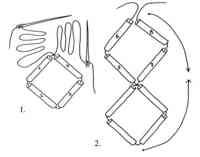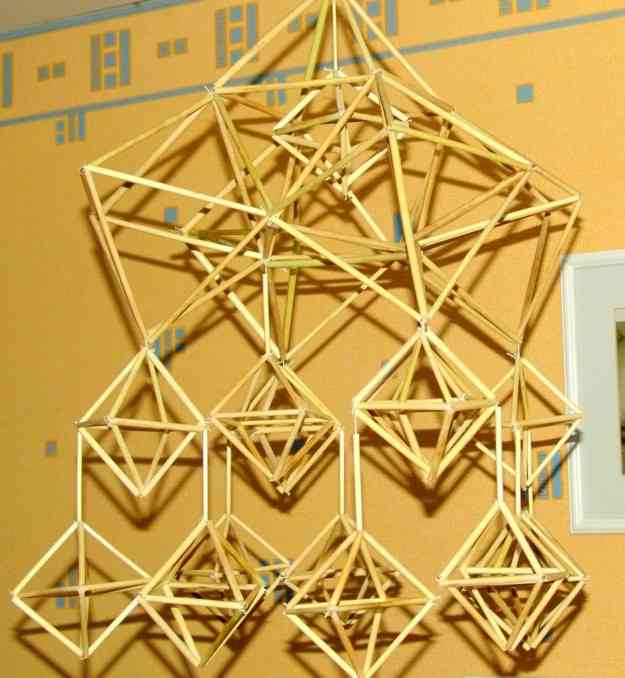 Making traditional jõulu/kroonid (Christmas crowns) is easy, at least the basic octahedron or eight-faceted shape. You don’t wear them, you hang them from the ceiling. Traditionally they’re made from straw (õle/kõrred) or reeds (pilli/roog), but these cubs and scouts in the Nõmme suburb of Tallinn artfully mastered the kaheksa/tahukas (octahedron) out of drinking straws (joogi/kõrred), which are colourful and easily available. From the left are scout leader Urmo Kesküla, Mihkel, Johanna, Liisa (with her back to us), Kristofer-Robin and Mattias. Photo: Riina Kindlam
Making traditional jõulu/kroonid (Christmas crowns) is easy, at least the basic octahedron or eight-faceted shape. You don’t wear them, you hang them from the ceiling. Traditionally they’re made from straw (õle/kõrred) or reeds (pilli/roog), but these cubs and scouts in the Nõmme suburb of Tallinn artfully mastered the kaheksa/tahukas (octahedron) out of drinking straws (joogi/kõrred), which are colourful and easily available. From the left are scout leader Urmo Kesküla, Mihkel, Johanna, Liisa (with her back to us), Kristofer-Robin and Mattias. Photo: Riina Kindlam
I have to admit, that although born in Canada, I have never had a Christmas cracker on my plate or cracked one open. On Christmas Eve, my plate was always a place for heeringas followed by verivorstid (blood sausages) and kalkun – that last one being Canadian. People in Estonia do not roast a turkey for Christmas or any other time of year for that matter. The only crackers known in Eesti are the thin, crisp biscuits known as a kreeker and firecrackers, known as ilu/tulestik, tule/värk and individually sometimes as a rakett.
As I’ve seen in other people’s photos, Christmas crackers, first conceived in London in 1846, usually contain a paper crown. Estonians, especially on the country’s western coast, have traditionally made crowns to hang above their heads, literally from the ceiling. They are thought to have been inspired by chandeliers (lühter or KROON/lühter) in churches and mõisad (manor houses). Made from pilli/roog (reeds) or straw (õled), they are part of a larger Scandinavian tradition of making Christmas decorations out of straw.
 String the initial 8 straws (or pieces of reed) onto a piece of lõng (yarn) or string. Then arrange it on a flat surface as two squares, side by side. Tie a sõlm (knot) in the spot between the two ruudud (squares). Hold from the knotted spot, letting the shapes hang down and the kroon is close to completion. EASY! You must now tie 4 individual straws horizontally around the shape’s middle, tying knots at each corner and you’re done! You can then make a tinier replica to go inside or more octahedrons to form a large chandelier-like ceiling decoration. Search for jõulukroon on the internet and you’ll see true blue examples. This diagram is from the hit which begins (e-ope.ee).
String the initial 8 straws (or pieces of reed) onto a piece of lõng (yarn) or string. Then arrange it on a flat surface as two squares, side by side. Tie a sõlm (knot) in the spot between the two ruudud (squares). Hold from the knotted spot, letting the shapes hang down and the kroon is close to completion. EASY! You must now tie 4 individual straws horizontally around the shape’s middle, tying knots at each corner and you’re done! You can then make a tinier replica to go inside or more octahedrons to form a large chandelier-like ceiling decoration. Search for jõulukroon on the internet and you’ll see true blue examples. This diagram is from the hit which begins (e-ope.ee).
Many have no doubt seen jõulu/sokud or Yule goats; jul/bock in Swedish, made of straw at Ikea stores. (Here’s the perfect moment to point out the linguistic pattern JUL > YULE > JÕUL!) Small Christmas tree ornaments made of straw are also a staple in Scandinavia and Swedes lived on Estonia’s eastern coast for centuries.
 A geometric Christmas wonder that brings luck, inspires and illuminates. This jõulukroon is made of pilliroog or the reed that grows along Eesti’s shores. It’s also the material out of which roo/katused or Estonian thatched roofs are made. Foto: Guido Koidik
A geometric Christmas wonder that brings luck, inspires and illuminates. This jõulukroon is made of pilliroog or the reed that grows along Eesti’s shores. It’s also the material out of which roo/katused or Estonian thatched roofs are made. Foto: Guido Koidik
If you wish to see a video of how a jõulukroon is made go: www.lastega.ee/index.php/et/joulukombed/1401-joulukroon A good diagram can also be followed from the hit page (search word “jõulukroon”) which begins (e-ope.ee). The corners of jõulukroonid were often decorated with red ribbons, yarn, feathers or even egg shells.
May your crops grow tall and your jõulud be bright!
Riina Kindlam,
Tallinn
















